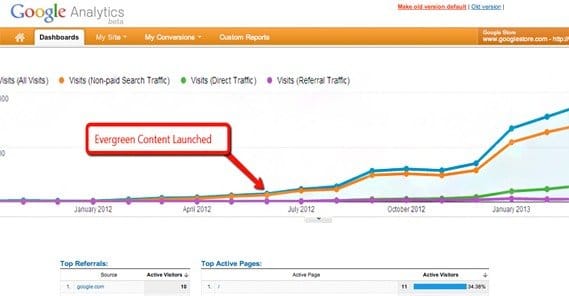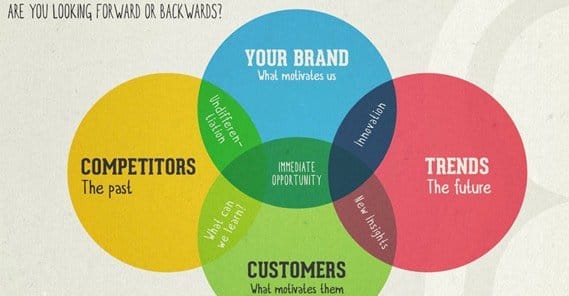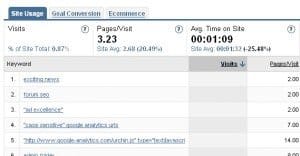Pros and Cons of Writing Based Solely on Evergreen Topics

Evergreen content is called such because, like evergreen trees, stays green and valuable throughout the year. This is in contrast to timely content, which is like the other sort of trees, staying green and pretty for a short time before losing leaves and dying come winter.
Evergreen content is great. It has a lot going for it. You can keep up with it for years, and it keeps bringing in users. Some will come back time and again for your reference, and it builds links exceptionally well. This leads some people to consider writing nothing but evergreen content for their sites. Unfortunately, this is a bit of a mistake.
Pro: Evergreen Content Lasts Forever
With a little upkeep, a piece of evergreen content lasts indefinitely. Take, for example, a set of instructions on using a piece of technology. That technology might go out of style, but it doesn’t cease to exist. Someone ten years from now might acquire that tech and want to know how to use it. You’d get a pageview from your guide even then, long after the heyday of the tech itself.
Or, as another example, a historical retrospective of an industry. You could write a long and in-depth analysis of the historical foundation and evolution of mechanized manufacturing. Even as the industry evolves, its history doesn’t change. Anyone looking into the past will see your resource as equally valuable no matter when they look it up.
As an added bonus, you can continue to add to the content. Some new development happens? You can add it to the end of the article, to keep your resource as current and updated as possible.
Con: Evergreen Lacks the Traffic of Timely Content
This is not to say that evergreen content can’t get a lot of traffic, but it tends to be a different sort of traffic. I think about it like this. Evergreen content is like a long, low, shallow hill. It’s a slight incline for miles and miles, with no end in sight. Meanwhile, timely content tends to be much more viral and prone to bursts of traffic. It’s the sheer mountain rising up out of the plain, with an abrupt start and an abrupt end. The terrain on the other side might be a little higher than the terrain on the starting side, but not by a lot.
Essentially, evergreen content is the tortoise, slow and steady with traffic growth. Timely content is the hare, with great bursts that just don’t last.
Pro: Evergreen Beginner’s Content is Great
When you’re writing content to be evergreen, you need to pay attention to your potential audience. If you’re writing content for beginners, congratulations! You’ve hit upon the secret to evergreen success.
The deeper you dig into evergreen content, the more you find yourself needing to talk about narrow niche topics or deep advanced user topics in order to find something new to say.
Con: Evergreen Expert’s Content is Often Too Narrow
The problem with writing evergreen content for advanced users is that you run afoul of, well, advanced users. Basically, one of three things will happen.
- Your content is perfect. Advanced users love it because it teaches them something new, and intermediate users love it because it gives them a resource for future learning.
- Your content is too basic, so any advanced user comes in and scoffs at you for writing something that “everyone already knows.” Your audience disappears.
- Your content is too advanced, so the selection of users who might be interested in it is incredibly small. As far as evergreen content goes, it has very little long-term growth potential and just peters out.
You’ll notice that two of the three results are detrimental as a whole. That’s the problem with targeting experts.
Pro: You can Write on Very Narrow Topics
Evergreen content is a great way to dig deep into topics as part of a larger overall content scheme. The best way to go about it would be to take a single topic and brainstorm as many ideas and sub-ideas as possible. Once you have this list, format it as a table of contents or “ultimate guide” sort of formatting. Turn every title and subtitle into a lengthy evergreen article, and link to them from your primary table of contents.
Con: Your Ability to Overlap Content is Limited
You do have to go into it planning ahead, however. Either that, or you’re going to have to do a reorganization later, possibly losing backlinks and traffic as a result.
The problem with evergreen content is the same as its benefit; it sticks around. If you want to cover another, similar topic, you have to be very careful not to be too similar, or else you’ll end up risking duplicate content penalties. Even if you aren’t penalized, you end up with users split between two pages rather than visiting and concentrating value on just one.
Pro: You can Keep it Updated
I mentioned this in passing before, but evergreen content is great as a resource specifically because you can keep it up to date. Whenever a new development comes up or a new angle is discovered, you can take advantage of it and add to your piece. This gives you the value of a timely piece, but also maintains your backlinks and existing traffic.
Con: Brainstorming Ideas Grows Harder Over Time
Evergreen content, because it never goes away, clutters the playing field. When it comes time to write a new piece of content, you can’t cover an old topic again from a new perspective; your evergreen content is in the way. You would be forced to edit the old content instead. You can’t cover topics too close to other existing topics, for the reasons mentioned above. You have to find a unique aspect or unique angle to cover, and that gets increasingly difficult over time.
In general, I find that a good mix of timely and evergreen content is necessary to the successful function of a blog. Very few blogs operate entirely on evergreen content, and when they do, they tend to be more wiki-like resources than blogs. On the other hand, some blogs can thrive with nothing but timely content, but they need a large staff of journalists and they need to be publishing numerous articles every day.
 ContentPowered.com
ContentPowered.com






